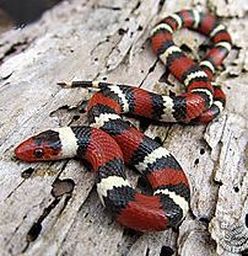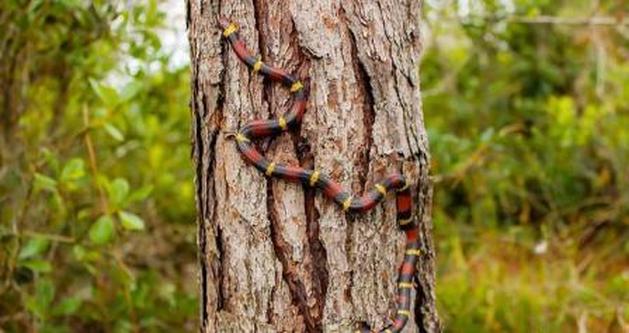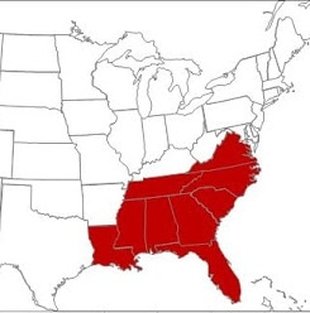Scarlet KingsnakeLampropeltis elapsoides |

Custom Search
|
|
The scarlet kingsnake (Lampropeltis elapsoides) is a kingsnake species found in the coastal regions of eastern and southeastern regions of the United States. Their range extends from southern New Jersey southward along the coast into eastern Louisiana, Alabama and all of Florida.
These non-venomous snakes commonly inhabit pine flatwood, pine savannas, bottomland, hardwood hammocks, mesic pine-oak forests, prairies, sandhills, swamps, and cultivated fields. But the scarlet kingsnake has also adapted to live in a variety of suburban habitats that have encroached on their natural habitat. There it's sometimes found in swimming pools particularly during the spring. The scarlet kingsnake is a terrestrial burrower often found hidden in rotting logs, under rocks or inside loose bark on dead trees mostly pine trees.But these snakes are also great climbers as well. They have a very secretive nature and are active mostly at night so they are rarely encountered by humans. Scarlet kingsnakes are the smallest species within their genus, Lampropeltis. Their adult size normally ranges between 14 and 20 inches in length (35 - 50 cm), with a maximum recorded length of 27 inches (68.5 cm). Their average weight is about 2.77 lb (1270 g).
The scarlet kingsnake has a very distinct tricolored pattern consisting of black, red, white, and several shades of yellow bands that encircle their entire body. Juveniles look very much like adult snakes but their yellow rings are lighter in color, appearing almost white.
As these snakes mature the yellowish banding gradually darkens, varying from school-bus yellow, lemon, tangerine, to apricot. The snout is pointed and red in color, with a wide black band running across the back of the head. Their scales are smooth and they have round pupils. Both the red and yellow rings are surrounded by black rings meaning the red and yellow rings never touch each other. This pattern appears to mimic a highly venomous snake, the Eastern coral snake (Micrurus fulvius), they probably get some protection from predators due to this form of mimicry. But it's also similar to that of the scarlet snake (Cemophora cocinnea) which is also a non-venomous snake species. This originated several rhymes and popular phrases to help differentiate them from the venomous coral snakes. "Red on yellow, kill a fellow, red on black venom at lack" "Red on yellow's a deadly fellow, yellow on black's a friendly Jack" "If red touches yellow, you're a dead fellow, if red touches black, you're all right, Jack" "Red and black is a friend of Billy Jack" "Red on black, friend of Jack, red on yellow, kill a fellow" "Red band near black, venom lack, red band near yellow, bite a fellow". But one evident difference is the red snout of the scarlet kingsnake as opposed to the black snout of the Eastern coral snake. With tri-colored snakes found east of the Mississippi River a simple phrase is used to remember this, "Red face, I'm safe." But probably the best advice is when in doubt do not try to touch or handle a snake.Their lifespan in the wild is about 10 to 15 years. Subspecies / Taxonomy / Etymology
There are no subspecies currently recognized by scientists. In the past, the scarlet kingsnake was classified as a milk snake subspecies, but more recent phylogenetic studies demonstrated they were more closely related to mountain kingsnakes found in the southwestern United States. In the past scientist thought that the Eastern milksnake integrated with the scarlet kingsnake producing a variant named Coastal Plains milk snake (Lampropeltis triangulum temporalis). This is no longer considered as a valid species. Diet / Feeding The scarlet kingsnake feeds mainly on other reptiles especially skinks and other small snakes, but they will also eat small rodents or eggs. The hatchlings and juvenile snakes show such a predilection for the ground skink (Scincella lateralis), that it sometimes comprises all of their diet. These snakes can be active during the day but usually, they are mostly active hunting at night from dusk to dawn. Reproduction The breeding season for the Scarlet Kingsnake runs from March to June. After breeding females lay the eggs from May to August usually in rotten logs or underground. The clutch size ranges from 2 to 9 eggs. The eggs hatch about 2 two months later, with the hatchlings measuring anywhere from 3 to 7 inches (8 - 18 cm). As many other reptiles like crocodiles and alligators, the incubation temperature of the eggs plays a role on the offspring's sex with cooler temperatures favoring the birth of females while warmer temperatures favor males. The baby snakes are similar in appearance to adult snakes they are just like miniature versions of them. The scarlet kingsnake reaches sexual maturity at 2 years of age. Conservation / Threats The scarlet kingsnake has not yet been assessed for the IUCN Red List of threatened species. They are also not listed on CITES and USFWS. Even so, the species is regarded as a low conservation concern. But some threats to the species include collection from the wild for the pet trade and indiscriminate killing out of fear due to confusion with other venomous snakes. Their appearance similar to that of the highly venomous Eastern coral snake puts many kingsnakes and milksnakes in the crosshairs and they are very often killed on sight. While excessive collection from the wild could further deplete populations in their natural habitat.
|
Did You Know?
A group of rattlesnakes is called a "rhumba" or "rumba" find some more amazing snake facts for kids. Scientific classification |
© 2014 Snake Facts About Us | Privacy Policy | Contact





